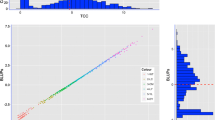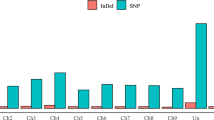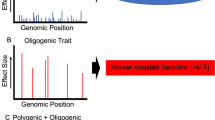Abstract
Cassava is a widely grown staple in Sub-Saharan Africa and consumed as a cheap source of calories, but the crop is deficient in micronutrients including pro-vitamin A carotenoids. This challenge is currently being addressed through biofortification breeding that relies on phenotypic selection. Gene-based markers linked to pro-vitamin A content variation are expected to increase the rate of genetic gain for this critical trait. We sequenced four candidate carotenoid genes from 167 cassava accessions representing the diversity of elite breeder lines from IITA. Total carotenoid content was determined using spectrophotometer and total β-carotene was quantified by high-performance liquid chromatography. Storage root yellowness due to carotenoid pigmentation was assessed. We carried out candidate gene association analysis that accounts for population structure and kinship using genome-wide single nucleotide polymorphisms (SNPs) generated through genotyping-by-sequencing. Significant SNPs were used to design competitive allele-specific PCR assays and validated on the larger population for potential use in marker-assisted selection breeding. Candidate gene sequencing of the genes β-carotene hydroxylase (crtRB), phytoene synthase (PSY2), lycopene epsilon cyclase (lcyE), and lycopene beta cyclase (lcyB) yielded a total of 37 SNPs. Total carotenoid content, total β-carotene, and color parameters were significantly associated with markers in the PSY2 gene. The SNPs from lcyE were significantly associated with color while those of lcyB and crtRB were not significantly associated with carotenoids or color parameters. These validated and breeder-friendly markers have potential to enhance the efficiency of selection for high β-carotene cassava, thus accelerating genetic gain.


Similar content being viewed by others
References
Akinwale MG, Aladesanwa RD, Akinyele BO et al (2010) Inheritance of β-carotene in cassava (Manihot esculenta crantza). Int J Genet Mol Biol 2:198–201
Altschul SF, Madden TL, Schäffer AA et al (1997) Gapped BLAST and PSI-BLAST: a new generation of protein database search programs. Nucleic Acids Res 25:3389–3402
Azmach G, Gedil M, Menkir A, Spillane C (2013) Marker-trait association analysis of functional gene markers for provitamin A levels across diverse tropical yellow maize inbred lines. BMC Plant Biol 13:227. https://doi.org/10.1186/1471-2229-13-227
Babu R, Rojas NP, Gao S et al (2013) Validation of the effects of molecular marker polymorphisms in LcyE and CrtRB1 on provitamin A concentrations for 26 tropical maize populations. Theor Appl Genet 126:389–399. https://doi.org/10.1007/s00122-012-1987-3
Bai L, Kim EH, Dellapenna D, Brutnell TP (2009) Novel lycopene epsilon cyclase activities in maize revealed through perturbation of carotenoid biosynthesis. Plant J 59:588–599. https://doi.org/10.1111/j.1365-313X.2009.03899.x
Bradbury PJ, Zhang Z, Kroon DE et al (2007) TASSEL: software for association mapping of complex traits in diverse samples. Bioinformatics 23:2633–2635. https://doi.org/10.1093/bioinformatics/btm308
Carvalho LJ, Agustini MA, Anderson JV et al (2016) Natural variation in expression of genes associated with carotenoid biosynthesis and accumulation in cassava (Manihot esculenta Crantz) storage root. BMC Plant Biol 16:133. https://doi.org/10.1186/s12870-016-0826-0
Cazzonelli CI (2011) Goldacre review: carotenoids in nature: insights from plants and beyond. Funct Plant Biol 38:833. https://doi.org/10.1071/FP11192
Chávez AL, Sánchez T, Jaramillo G et al (2005) Variation of quality traits in cassava roots evaluated in landraces and improved clones. Euphytica 143:125–133. https://doi.org/10.1007/s10681-005-3057-2
Clamp M, Cuff J, Searle SM, Barton GJ (2004) The Jalview Java alignment editor. Bioinformatics 20:426–427. https://doi.org/10.1093/bioinformatics/btg430
De Moura FF, Moursi M, Lubowa A et al (2015) Cassava intake and vitamin A status among women and preschool children in Akwa-Ibom, Nigeria. PLoS One 10:e0129436. https://doi.org/10.1371/journal.pone.0129436
Esuma W, Herselman L, Labuschagne MT et al (2016) Genome-wide association mapping of provitamin A carotenoid content in cassava. Euphytica 212:97–110. https://doi.org/10.1007/s10681-016-1772-5
FAO (2013) Save and Grow: Cassava. A guide to sustainable production intensification. FAO, Rome, pp 130. http://www.fao.org/ag/save-and-grow/cassava/index_en.html
Ferguson M, Rabbi I, Kim DJ et al (2012) Molecular markers and their application to cassava breeding: past, present and future. Trop Plant Biol 5:95–109. https://doi.org/10.1007/s12042-011-9087-0
Fu Z, Chai Y, Zhou Y et al (2013) Natural variation in the sequence of PSY1 and frequency of favorable polymorphisms among tropical and temperate maize germplasm. Theor Appl Genet 126:923–935. https://doi.org/10.1007/s00122-012-2026-0
Giuliano G (2014) Plant carotenoids: genomics meets multi-gene engineering. Curr Opin Plant Biol 19:111–117. https://doi.org/10.1016/j.pbi.2014.05.006
Hannoufa A, Hossain Z (2012) Regulation of carotenoid accumulation in plants. Biocatal Agric Biotechnol 1:198–202. https://doi.org/10.1016/j.bcab.2012.03.004
Harjes CE, Rocheford TR, Bai L et al (2008) Natural genetic variation in lycopene epsilon cyclase tapped for maize biofortification. Science 319:330–333. https://doi.org/10.1126/science.1150255
Howe JA, Tanumihardjo SA (2006) Evaluation of analytical methods for carotenoid extraction from biofortified maize ( Zea mays sp.) J Agric Food Chem 54:7992–7997. https://doi.org/10.1021/jf062256f
Iglesias C, Mayer J, Chavez L, Calle F (1997) Genetic potential and stability of carotene content in cassava roots. Euphytica 94:367–373. https://doi.org/10.1023/A:1002962108315
Lodhi MA, Ye G-N, Weeden NF, Reisch BI (1994) A simple and efficient method for DNA extraction from grapevine cultivars and Vitis species. Plant Mol Biol Report 12:6–13. https://doi.org/10.1007/BF02668658
Ly D, Hamblin M, Rabbi I et al (2013) Relatedness and genotype × environment interaction affect prediction accuracies in genomic selection: a study in cassava. Crop Sci 53:1312–1325. https://doi.org/10.2135/cropsci2012.11.0653
Marín Colorado JA, Ramírez H, Fregene M (2009) Genetic mapping and QTL analysis for carotenes in a S1 population of cassava. Acta Agron Univ Nac Colomb 58:15–21
Nisar N, Li L, Lu S et al (2015) Carotenoid metabolism in plants. Mol Plant 8:68–82. https://doi.org/10.1016/j.molp.2014.12.007
Njoku DN, Gracen VE, Offei SK, Asante IK, Danquah EY, Egesi CN, Okogbenin E (2014) Molecular marker analysis of F1 progenies and their parents for carotenoids inheritance in African cassava (Manihot esculenta Crantz). Afr J Biotechnol 13(40):3999-4007
Okechukwu RU, Dixon AGO (2008) Genetic gains from 30 years of cassava breeding in Nigeria for storage root yield and disease resistance in elite cassava genotypes. J Crop Improv 22:181–208. https://doi.org/10.1080/15427520802212506
Patnala R, Clements J, Batra J (2013) Candidate gene association studies: a comprehensive guide to useful in silico tools. BMC Genet 14:39. https://doi.org/10.1186/1471-2156-14-39
Pfeiffer WH, McClafferty B (2007) HarvestPlus: breeding crops for better nutrition. Crop Sci 47:S-88. https://doi.org/10.2135/cropsci2007.09.0020IPBS
Price AL, Zaitlen NA, Reich D, Patterson N (2010) New approaches to population stratification in genome-wide association studies. Nat Rev Genet 11:459–463. https://doi.org/10.1038/nrg2813
Rabbi I, Hamblin M, Gedil M et al (2014) Genetic mapping using genotyping-by-sequencing in the clonally propagated cassava. Crop Sci 54:1384–1396. https://doi.org/10.2135/cropsci2013.07.0482
Rodriguez-Amaya DB, Kimura M (2004) HarvestPlus handbook for carotenoid analysis. International Food Policy Research Institute (IFPRI), Washington, pp 58. http://www.harvestplus.org/sites/default/files/tech02.pdf
Ruiz-Sola MÁ, Rodríguez-Concepción M (2012) Carotenoid biosynthesis in Arabidopsis: a colorful pathway. Arabidopsis Book 10:e0158. https://doi.org/10.1199/tab.0158
Saltzman A, Birol E, Bouis HE et al (2013) Biofortification: progress toward a more nourishing future. Glob Food Sec 2:9–17. https://doi.org/10.1016/j.gfs.2012.12.003
Sánchez T, Ceballos H, Dufour D et al (2014) Prediction of carotenoids, cyanide and dry matter contents in fresh cassava root using NIRS and Hunter color techniques. Food Chem 151:444–451. https://doi.org/10.1016/j.foodchem.2013.11.081
Thompson JD, Higgins DG, Gibson TJ (1994) CLUSTAL W: improving the sensitivity of progressive multiple sequence alignment through sequence weighting, position-specific gap penalties and weight matrix choice. Nucleic Acids Res 22:4673–4680
Tonukari NJ (2004) Cassava and the future of starch. Electron J Biotechnol 7:12–15. https://doi.org/10.2225/vol7-issue1-fulltext-i02
VanRaden PM (2008) Efficient methods to compute genomic predictions. J Dairy Sci 91:4414–4423. https://doi.org/10.3168/jds.2007-0980
von Grebmer K, Saltzman A, Birol E, Wiesmann D, Prasai N, Yin S, Yohannes Y, Menon P, Thompson J, Sonntag A (2014) 2014 Global Hunger Index: The Challenge of Hidden Hunger. Welthungerhilfe, International Food Policy Research Institute, and Concern Worldwide, Bonn, Washington, D.C., and Dublin, pp 50. http://dx.doi.org/10.2499/9780896299580
Welsch R, Arango J, Bär C et al (2010) Provitamin A accumulation in cassava (Manihot esculenta) roots driven by a single nucleotide polymorphism in a phytoene synthase gene. Plant Cell 22:3348–3356. https://doi.org/10.1105/tpc.110.077560
West KP, Mehra S (2010) Vitamin a intake and status in populations facing economic stress. J Nutr 140:201S–207S. https://doi.org/10.3945/jn.109.112730
Wolfe MD, Rabbi IY, Egesi C et al (2016) Genome-wide association and prediction reveals genetic architecture of cassava mosaic disease resistance and prospects for rapid genetic improvement. Plant Genome 9:1–248. https://doi.org/10.3835/plantgenome2015.11.0118
Yan J, Kandianis CB, Harjes CE et al (2010) Rare genetic variation at Zea mays crtRB1 increases beta-carotene in maize grain. Nat Genet 42:322–327. https://doi.org/10.1038/ng.551
You FM, Huo N, Gu Y et al (2008) BatchPrimer3: a high throughput web application for PCR and sequencing primer design. BMC Bioinformatics 9:253. https://doi.org/10.1186/1471-2105-9-253
Zhu M, Zhao S (2007) Candidate gene identification approach: progress and challenges. Int J Biol Sci 3:420–427
Acknowledgements
We acknowledge the support of Ruth Uwugiaren and Tessema Gezahegn in the laboratory work and Andrew Ikpan and the staff of the Cassava Breeding Unit of IITA for conducting field trials. The Next Generation Cassava Breeding project (www.nextgencassava.org) is appreciated for providing the genome-wide information on the SNPs of the population used in this study. This research was part of a PhD project supported by the HarvestPlus Project and the CGIAR Research Program on Roots, Tubers, and Bananas (CRP-RTB).
Author information
Authors and Affiliations
Contributions
LU conducted the field and laboratory experiments, carried out statistical analysis, and prepared the draft manuscript. MG supervised the laboratory work and revised the manuscript. EP and PK contributed in securing funds for the project and revised the manuscript. AA contributed to supervision of the work and revised the manuscript. CN contributed to the laboratory and field work and revised the manuscript. IR conceived and led the project, took part in statistical analysis, and contributed to drafting the manuscript.
Corresponding authors
Ethics declarations
Ethics approval and consent to participate
Not applicable.
Consent for publication
Not applicable.
Availability of data and materials
The datasets generated during and/or analyzed during the current study are available at www.cassavabase.org, ftp://ftp.cassavabase.org/manuscripts/MolecularBreeding_Udoh_et_al_2017.zip.
Competing interest
The authors declare that they have no competing interest.
Electronic supplementary material
Supplementary Table 1
Sequences of PSY2 and lcyE SNP used for competitive allele specific PCR marker development (DOCX 51.5 KB).
Supplementary Table 2
Summary of the sequenced candidate genes, uncovered SNPs and resultant amino acid changes (DOCX 84.5 KB).
Supplementary Fig. 1
Simplified diagram of the carotenoid biosynthetic pathway in plants, adapted from (Ampomah-Dwamena et al. 2009). The candidate genes sequenced in the present study are denoted in red fonts. PSY2, phytoene synthase; PDS, phytoene desaturase; Z-ISO, ζ-carotene isomerase; ZDS, ζ-carotene desaturase; CRTISO, carotenoid isomerase; crtRB, β-carotene hydroxylase; lcyE, lycopene epsilon cyclase; lcyB, lycopene beta cyclase; crtRB, β-carotene hydroxylase (PDF 34.5 KB).
Supplementary Fig. 2
Distribution of carotenoid estimates. (a) yellow color intensity as estimated using chromameter b* reading; (b) carotenoids quantified using iCheck Fluoro; and (c) visually scored root yellowness using color chart scores (PDF 42.3 KB).
Supplementary Fig. 3
Alignment of the three cassava Phytoene synthase genes from the reference genome compared with PSY2 from re-sequencing of other white- and yellow-root cassava clones as well as other species (PDF 950 KB).
Supplementary Fig. 4
Pattern of linkage disequillibrium as measured by squared correlation coefficient (r2) of alleles occurring between and within the candidate genes in this study (lcyE, lcyB, crtRB and PSY2). Note the extensive LD in lcyB (PDF 96.7 KB).
Supplementary Fig. 5
Comparison of various association mapping models using Q-Q plot of observed against expected p-values. a) BLUPs of Total carotenoids estimated by spectrophotometer, b) total β-carotene (TBC), c) Total carotenoids estimated by iCheck Fluoro and d) chromameter b*. The naïve and P model show the most inflated p-value (PDF 98.0 KB).
Rights and permissions
About this article
Cite this article
Udoh, L.I., Gedil, M., Parkes, E.Y. et al. Candidate gene sequencing and validation of SNP markers linked to carotenoid content in cassava (Manihot esculenta Crantz). Mol Breeding 37, 123 (2017). https://doi.org/10.1007/s11032-017-0718-5
Received:
Accepted:
Published:
DOI: https://doi.org/10.1007/s11032-017-0718-5




